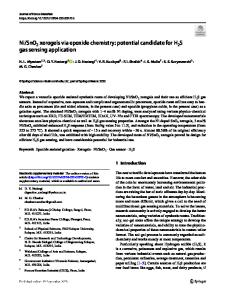Structural and optical properties of pure SnO 2 and V 2 O 5 /SnO 2 nanocomposite thin films for gas sensing application
- PDF / 4,638,130 Bytes
- 12 Pages / 595.276 x 790.866 pts Page_size
- 81 Downloads / 304 Views
Structural and optical properties of pure SnO2 and V2O5/SnO2 nanocomposite thin films for gas sensing application V. Janakiraman1 · V. Tamilnayagam2 · R. S. Sundararajan1 · S. Suresh3 · C. S. Biju4 Received: 16 May 2020 / Accepted: 25 July 2020 © Springer Science+Business Media, LLC, part of Springer Nature 2020
Abstract In this study, pure S nO2 and V 2O5/SnO2 nanocomposite thin film N H3 sensors with varying V 2O5 contents were successfully prepared by spray pyrolysis method. The prepared thin films were characterized by X-ray diffraction, Field emission scanning electron microscopy, Energy dispersive X-ray spectroscopy, Fourier-transform infrared spectroscopy, stylus profilometry and Ultra violet–Visible and transmittance spectroscopies. NH3 gas sensing property was also studied. XRD results suggested that all the thin films exhibited a tetragonal rutile crystal structure, while the average crystallite size increases with V2O5 content. FESEM images of the thin films showed the presence of both nano and micro-sized grains in the range ~ 53–194 nm. EDX spectra confirmed the inclusion of V 2O5 into the S nO2 matrix. The vibrational bands associated with the thin films were verified from the FTIR spectra. Thickness measurements revealed that the thickness increases with V 2O5 content. Change in transparency and bandgap narrowing were also noticed from the transmittance and UV–Vis spectra. N H3 gas sensing measurements suggested that the transient resistance of V 2O5/SnO2 thin film was lower than pure S nO2. Further, in the operating temperature 300 °C and 100 ppm NH3 gas, the sensor response of V2O5/ SnO2 thin film (99.13) is found to be higher than pure S nO2 thin film (92.34). Also, the response and recovery times of pure S nO2 thin film (30 and 44 s) are lower than V 2O5/SnO2 thin film (39 and 180 s). These results indicate that V2O5/SnO2 thin film could serve as a suitable material for NH3 gas sensing application.
1 Introduction Ammonia (NH3) is considered as one of the key precursors to synthesize various materials in chemical industries [1]. It is a colourless gas which could stimulate eye and nose, * V. Janakiraman [email protected] * S. Suresh [email protected] * C. S. Biju [email protected] 1
PG & Research Department of Physics, Government Arts College (Autonomous) (Affiliated to Bharathidasan University), Kumbakonam, Tamil Nadu 612002, India
2
Department of Physics, A.P.A. College of Arts & Culture, Palani, Dindigul, Tamil Nadu, India
3
Departments of Physics, Saveetha Engineering College (Autonomous), Thandalam, Chennai, Tamil Nadu 602105, India
4
Department of Physics, Malankara Catholic College, Mariagiri, Kaliakkavilai, Tamil Nadu 629153, India
and consequently vomit and headache occurs. Therefore an attractive method to sense the presence of NH3 in the atmosphere is much essential in the field of environmental measurement and control. Semiconductor-based sensors have been extensively investigated to detect gas components eve
Data Loading...











